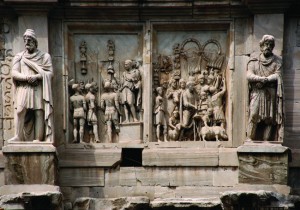With incredible detailed stonework, the Arch of Constantine on the Via di San Gregario in Rome marks a significant historical victory that changed the course of religion?
The impressive Arco di Costantino is one of the key architectural sights of ancient Rome. Located between the Colosseum and the Palatine Hill, it was built to celebrate the victory of Emperor Constantineat the Battle of Milvian Bridge in 312 AD. This was ultimately a significant watershed moment in Roman history, as Constantine became the first ruler to believe in a Christian god and therefore halted the persecution of Christians across the Empire. The important structure, which stands at a height of 21m and has three arches in total, has been well preserved and still attracts much attention from tourists today. The more intricate sculptures ? located higher up the archway ? are thought to be taken from the older Forum of Trajan, and depict the Dacian soldiers who have been captured by the Trajan army. This form of sculptural ‘recycling’ was frequent practice during the later years of the Roman Empire, although the faces of some figures on the Arch of Constantine were redesigned to better resemble that of the Emperor.

